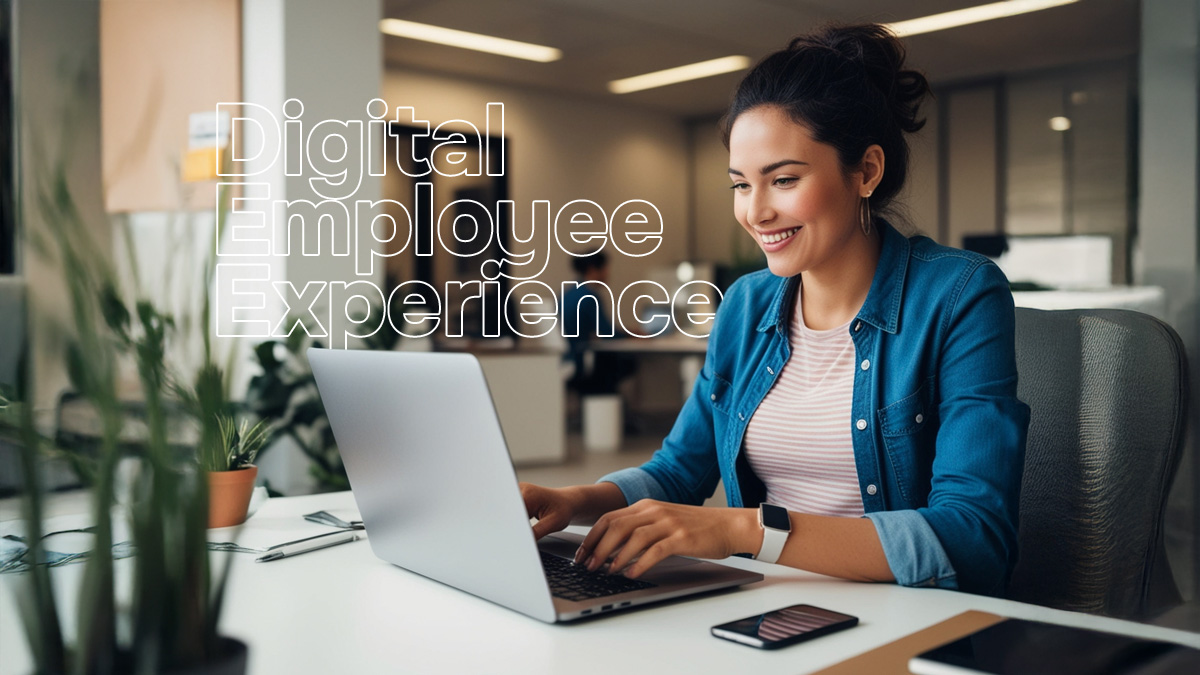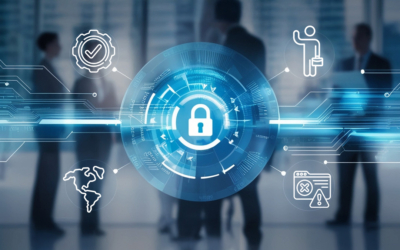Digital employee experience (DEX) focuses on the interaction between employees and workplace digital tools. A positive DEX boosts productivity and job satisfaction, making daily tasks seamless. This article covers what DEX is, its importance, and how to enhance it.
Key Takeaways
- Digital Employee Experience (DEX) enhances employee satisfaction and productivity by ensuring effective interaction with digital tools, requiring clear roadmap and goals for implementation.
- A successful DEX strategy incorporates user-centric design, seamless integration of tools, and continuous feedback to address employee needs and improve engagement.
- Overcoming challenges such as budget constraints, resistance to change, and technology selection is crucial for effective DEX implementation and future innovations in AI, personalization, and employee well-being.
Understanding digital employee experience (DEX)
Digital Employee Experience (DEX) aims to enhance the overall work experience of employees by ensuring effective interaction with digital tools. A well-implemented DEX can significantly influence employees’ job satisfaction and productivity, creating a seamless digital workplace.
Organizations should establish a clear roadmap and goals to create a vision for enhancing DEX, focusing on both digital and physical aspects of the employee experience.
What is DEX?
Digital Employee Experience (DEX) refers to the sum of all perceptions employees have about working with technology for daily tasks and employer interactions. It encompasses the interaction between employees and digital tools in their workspace, impacting their productivity and satisfaction. Employees expect seamless technology similar to their personal lives, influencing their adaptation to workplace tools.
An optimal DEX ensures consistent engagement throughout the employee lifecycle, addressing challenges like difficulty accessing information or completing tasks with provided tools.
To the point, the importance of DEX
A strong digital employee experience strategy is essential for maintaining employee satisfaction and retention in a competitive job market. Prioritizing DEX supports seamless work experiences, ensuring productivity and satisfaction for employees regardless of location. Engaged employees are more likely to feel a connection to their company and help achieve organizational goals.
Enhancing DEX can also have financial benefits, as disengaged employees can cost businesses significantly. Overall, a well-implemented DEX boosts employee satisfaction and retention, driving business success.
Key components of a successful DEX strategy
A successful digital employee experience strategy includes several key components: user-centric design, seamless integration, and continuous feedback. These elements ensure that digital tools and systems are effective, intuitive, and aligned with employees’ needs, ultimately leading to higher satisfaction and engagement.
Companies that prioritize these components typically see improved overall performance and reduced turnover rates.
User-centric design
Designing digital tools with the employee’s needs in mind can significantly enhance productivity and satisfaction. Personalizing the employee experience by recognizing individual work styles and preferences leads to improved engagement and productivity.
Employees expect their workplace digital interactions to be as seamless and intuitive as their personal technology experiences. Ensuring a seamless user experience throughout the employee journey is crucial for a great digital employee experience.
Seamless integration
Seamless integration of digital tools is crucial as it fosters a smoother workflow, ultimately enhancing the digital employee experience. Integrated tools and systems streamline workflows, contributing to increased productivity and satisfaction among employees. They also reduce potential frustrations that arise from using disconnected systems.
An effective integration strategy aligns technology tools in a way that simplifies, rather than complicates, the employee experience.
Continuous feedback
Regularly collecting employee feedback is essential for identifying issues and enhancing the digital employee experience. Data plays a significant role in this process by helping identify pain points and areas for improvement. Employee feedback can be gathered through various methods, including surveys, focus groups, and interviews.
Understanding employee needs and expectations through continuous feedback ensures that the digital workplace remains responsive and adaptive.
Best practices for enhancing DEX
Enhancing digital employee experience requires addressing employees’ pain points and ensuring that digital tools are accessible, helpful, and reliable. Best practices include focusing on structured onboarding, ongoing training, and recognition.
Incremental steps can effectively improve the employee experience, ensuring that changes are manageable and sustainable.
Effective onboarding process
Structured onboarding processes are essential for integrating new hires effectively into the company culture. Organizing video calls for in-house and remote employees to introduce themselves can improve onboarding for remote employees. Sending a welcome gift, such as favorite snacks or custom notes, is a strategy for welcoming new remote employees. Effective onboarding helps increase employee engagement and employee retention, contributing to a positive employee experience throughout the employee lifecycle. At our company, we place great importance on these periods as it is crucial that new employees adapt seamlessly to our community.
Training programs
Ongoing training programs are vital for empowering employees and enhancing their engagement in the workplace. By participating in ongoing training, employees feel more competent and are likely to contribute more effectively. Our company fosters both internal and external training initiatives. We invite external experts to conduct specialized workshops, sharing their knowledge and expertise with our team. Additionally, we have a robust internal training program where our own experts deliver sessions, promoting knowledge sharing and skill development within the organization. AI algorithms are increasingly used to create personalized experiences throughout an employee’s career journey, enhancing satisfaction and engagement. Integrating AI in training programs tailors learning experiences, keeping employees motivated and committed to their roles.
Tools to improve digital employee experience
Several tools can significantly enhance the digital employee experience solution, including communication tools, project management software, and employee engagement tools platforms.
These tools should be user-friendly, integrative, intuitive, and require minimal training to support employees effectively.
Communication tools
Google Chat offers free video and voice call features, integrating seamlessly with Google’s suite of applications. Collaboration platforms like Microsoft Teams and Slack facilitate effective communication across dispersed teams. Blink is a communication app designed for frontline workers, providing essential tools for engagement and connectivity.
Effective internal communication fosters collaboration and improves overall employee engagement. At giga we are fans of the entire Microsoft universe.
Project management software
Asana is a tool that can help streamline workflows and boost productivity, particularly for remote teams. Monday.com functions as a project management tool by enabling task tracking and promoting team collaboration. ClickUp enhances project management with features like task assignments and progress alerts.
Project management tools play a vital role in streamlining workflows and increasing team productivity, especially in remote settings.
Measuring the Impact of DEX
Continuous evaluation and iterative improvement are essential for maintaining an effective digital employee experience. Gathering user feedback and monitoring digital tool performance are key methods to measure DEX.
Methods such as surveys, interviews, and observing day-to-day operations provide insights about current technology effectiveness.
Employee engagement surveys
Surveys are considered the best way to measure employee engagement and employee sentiment within the organization. Pulse polls, which are short and frequent surveys, provide immediate insights into employee feelings and sentiments. Regular feedback from employees is essential to improve the digital employee experience.
Engagement of remote employees can be measured through effective communication to engage remote employees regarding their work and concerns, including remote employee engagement, remote employees engaged, and remote workers.
Usage analytics
By monitoring workplace tool usage, significant issues with the digital employee experience can be uncovered. This insight is crucial for enhancing overall employee satisfaction. Usage patterns and their impact on productivity and satisfaction should be actively monitored. Comprehensive dashboards integrate data from various touchpoints and systems, providing a holistic view of digital tool performance.
Tracking metrics such as end-user data, system performance, and latency time is crucial for identifying areas needing improvement.
Continuous listening
Organizations should implement continuous feedback mechanisms to remain responsive to changing employee needs. Continuous feedback helps in identifying and addressing employee pain points effectively.
Ongoing management and adaptation to technological advancements are essential for evolving the digital employee experience management.
At Giga, we firmly believe that listening to our community is key to understanding their needs and continuously improving. We maintain open and transparent communication through various initiatives, such as open door HR policies. Additionally, we include surveys and forms in all our activities to encourage participation and gather valuable feedback. This allows us to build a collaborative work environment and effectively meet the expectations of our employees.
Shaping the future: digital employee experience
Emerging trends in digital employee experience aim to improve efficiency, satisfaction, and engagement. AI and automation are anticipated to streamline workflows and provide insights that enhance decision-making for employeesf
Personalized digital tools will cater to individual employee preferences, leading to enhanced engagement and productivity. An increased focus on employee well-being is expected, with new tools designed to support mental and physical health.
AI and automation
AI optimizes digital experiences by adapting to user preferences and providing personalized content. Automation through AI enables self-healing workflows, reducing the need for manual interventions. By reducing the help desk load, AI allows employees to focus on more strategic tasks, enhancing overall productivity.
AI is transforming digital employee experiences by introducing innovative solutions that cater to employee needs.
Enhanced personalization
Flexibility is essential for enabling personalized employee experiences, as it allows for tailored work arrangements that align with individual preferences. The future of digital employee experience is expected to revolve around personalized tools that cater to individual preferences. Tailored work arrangements not only improve employee satisfaction but also boost overall productivity and engagement.
As workplaces evolve, the integration of personalized digital tools and workplace technology will likely become a standard practice, influencing the overall digital employee experience.
Increased focus on well-being
Mental health benefits and Employee Assistance Programs are essential for supporting employees’ mental well-being. Programs such as personal money management and professional counseling play a vital role in supporting employee well-being. Guided group meditation is a suggested method to promote team members’ mental health, especially in remote work settings.
Healthier employees are more productive and engaged, which benefits the organization. Flexibility in work hours has become essential as employees seek better work-life balance.
In conclusion, enhancing your digital employee experience is not just about integrating cutting-edge technology but also about creating a seamless, engaging, and supportive work environment. By understanding what DEX is and why it is important, focusing on user-centric design, seamless integration, and continuous feedback, and implementing best practices such as effective onboarding, ongoing training, and employee recognition, organizations can significantly improve their DEX. Employing the right tools and measuring their impact through surveys, analytics, and continuous listening will ensure continuous improvement. Overcoming challenges like budget constraints, resistance to change, and selecting the right technology will pave the way for successful DEX implementation. Looking ahead, trends like AI, enhanced personalization, and a focus on well-being will shape the future of digital employee experience. Embrace these strategies, and you will foster a more engaged, satisfied, and productive workforce. If you want to know more about how we work at Giga,
click here.Frequently Asked Questions
What is Digital Employee Experience (DEX)?
Digital Employee Experience (DEX) encompasses all perceptions employees have regarding their interactions with technology while performing daily tasks and engaging with their employer. It reflects the overall effectiveness and usability of digital tools in the workplace.
Why is DEX important for businesses?
A strong DEX strategy is crucial for businesses as it enhances employee satisfaction and retention, ultimately driving productivity and success. Prioritizing digital employee experiences can lead to a more engaged and effective workforce.
What are the key components of a successful DEX strategy?
A successful DEX strategy hinges on user-centric design, seamless integration, and continuous feedback, ensuring effectiveness and alignment with employee needs. Prioritizing these components will enhance overall productivity and satisfaction.
How can companies measure the impact of their DEX initiatives?
Companies can effectively measure the impact of their DEX initiatives by employing employee engagement surveys, analyzing usage analytics, and implementing continuous listening strategies. These approaches provide valuable insights into technology effectiveness and employee sentiment.
What future trends are shaping the digital employee experience?
Future trends shaping the digital employee experience include the integration of AI and automation, enhanced personalization of digital tools, and a strong focus on employee well-being. These developments are designed to boost efficiency, satisfaction, and engagement within the workforce.





0 Comments